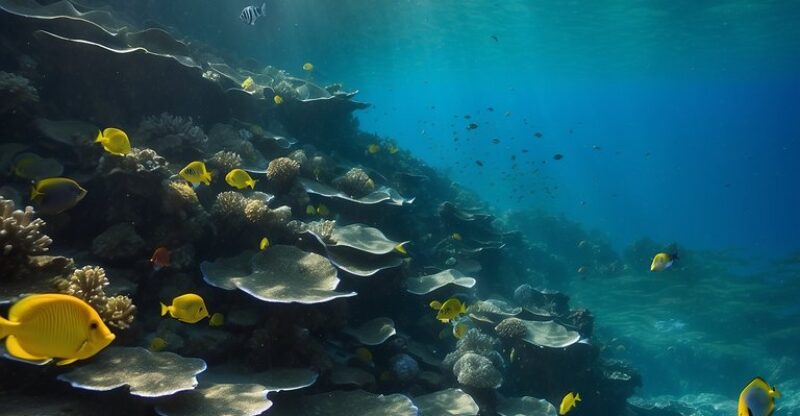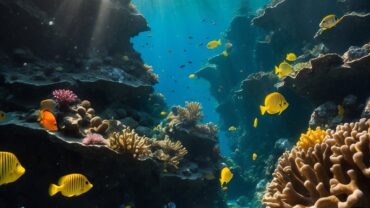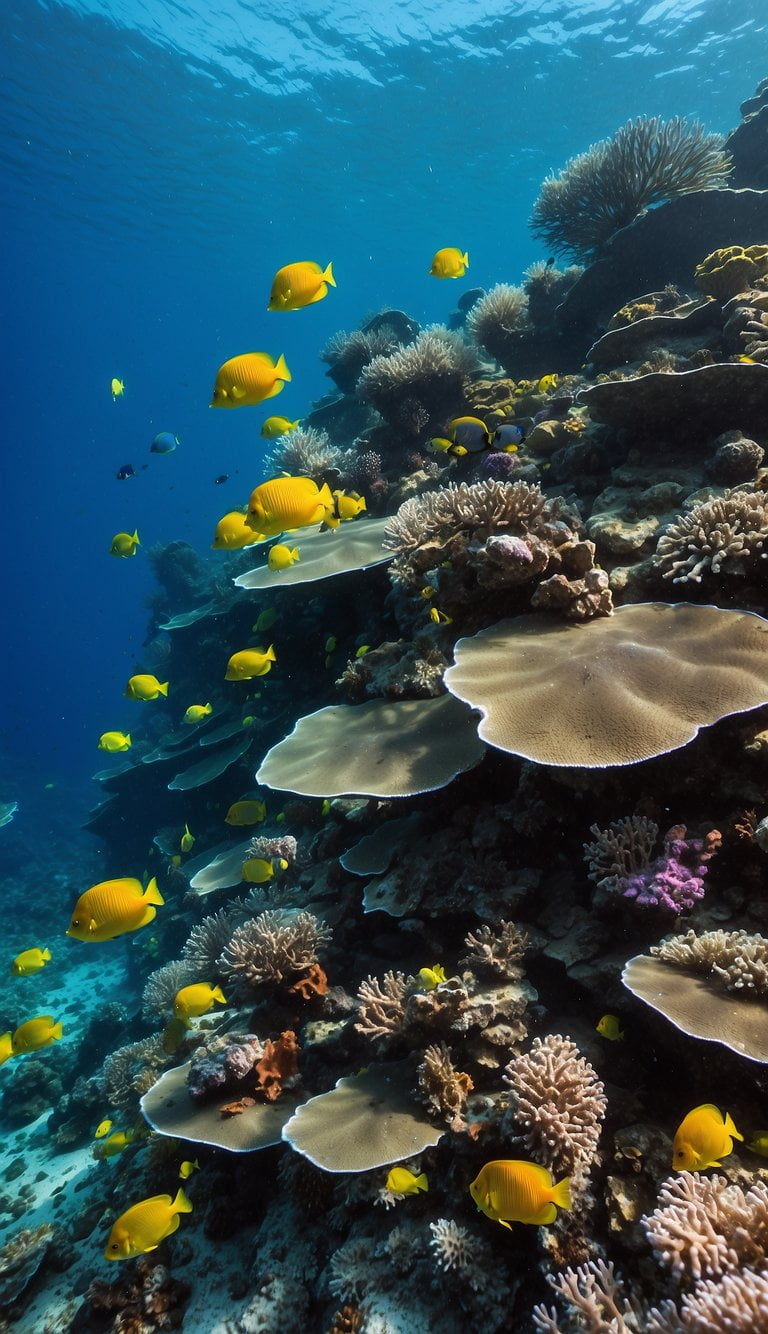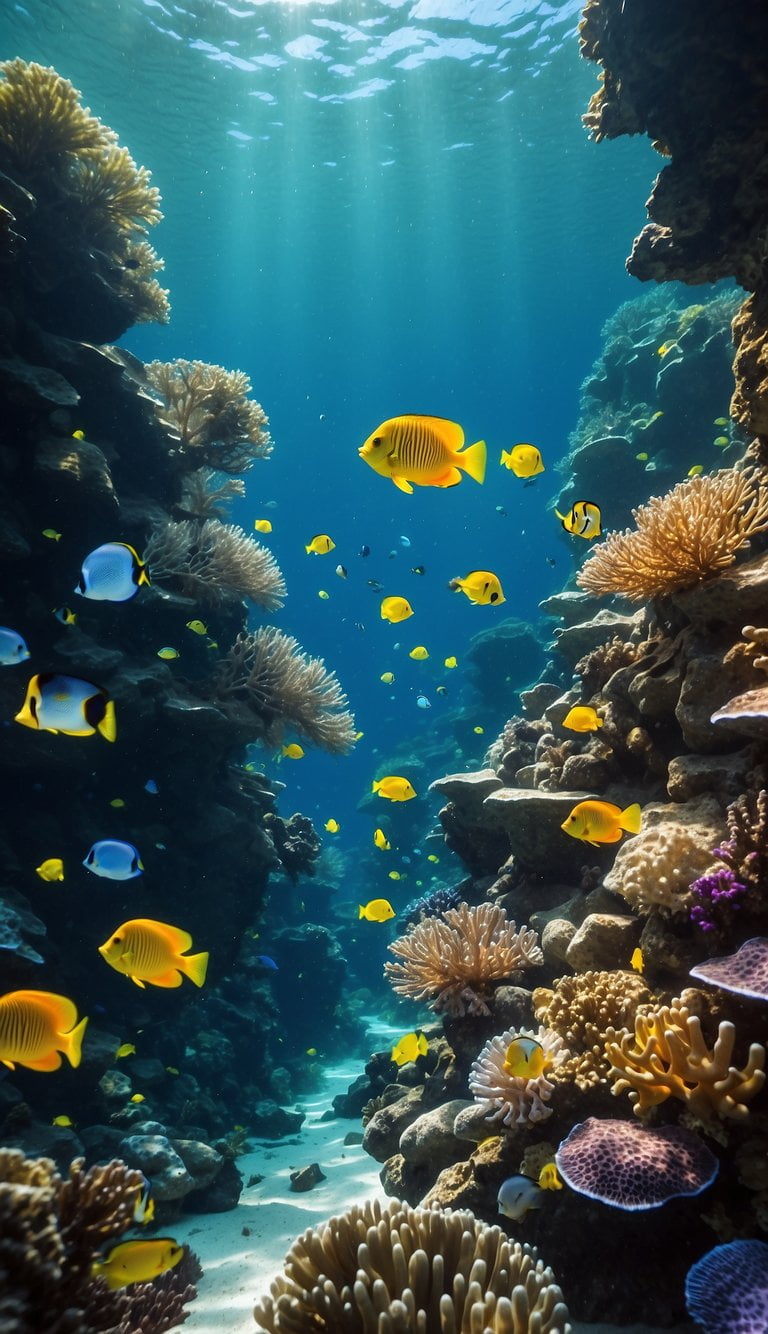Best Scuba Diving in the Atlantic and Mediterranean: Top Sites and Tips
Scuba diving enthusiasts looking for incredible underwater adventures need to explore both the Atlantic Ocean and the Mediterranean Sea. The best dive sites in these regions offer breathtaking marine biodiversity, stunning coral reefs, and intriguing shipwrecks. Whether you’re a seasoned diver or a beginner, these waters provide experiences that cater to all skill levels.

In the Mediterranean, locations like MS Zenobia in Cyprus and Costa Brava in Spain are popular due to their vibrant marine life and fascinating underwater structures. Meanwhile, the Atlantic offers its own charm, with spots like the Bahamas and the Azores providing crystal clear waters and an abundance of sea creatures.
Key Takeaways
- The Atlantic and Mediterranean offer top diving sites with rich marine biodiversity.
- Dive sites like MS Zenobia and Costa Brava are famous in the Mediterranean.
- The Atlantic’s Bahamas and Azores provide clear waters and diverse sea life.
History of Scuba Diving in the Atlantic and Mediterranean

Scuba diving has a rich and storied history in both the Atlantic and Mediterranean.
Atlantis and Early Innovations
In the Atlantic, early diving efforts date back to the 16th century when diving bells were first used. By the 1940s, regulators like the one invented by Jacques Cousteau and Émile Gagnan allowed for deeper and longer dives. These advances laid the groundwork for modern scuba diving.
Mediterranean’s Unique Development
The Mediterranean Sea, surrounded by Europe, Africa, and Asia, has been a focal point for diving due to its rich marine biodiversity. Ancient divers harvested sponges and coral as early as 1000 B.C. The modern era saw rapid development of diving technology, with many dive sites being explored and charted.
Growth of Recreational Diving
The 1950s and 60s saw scuba diving become more popular as a recreational activity. Technological advancements in both regions made diving equipment safer and more accessible. This era marked the beginning of organized dive training and certification programs.
Popular Dive Sites
In the Atlantic, places like the Bahamas and Bermuda gained fame for their clear waters and abundant marine life. In the Mediterranean, areas such as the Costa Brava and wreck sites like the MS Zenobia attracted divers from around the world.
Environmental Efforts
Both regions have seen increased efforts to preserve marine environments. Dive organizations and local governments have introduced measures to protect underwater ecosystems, ensuring sustainable diving tourism.
The evolution of scuba diving in the Atlantic and Mediterranean continues to inspire and attract enthusiasts globally.
Choosing the Right Diving Gear

Selecting proper diving gear is vital for scuba divers, especially in diverse diving spots such as the Atlantic and Mediterranean.
Mask
A reliable diving mask is essential. The Cressi F1 offers a frameless design that ensures clear visibility underwater.
Fins
The right fins provide efficient propulsion. The Cressi Gara Modular Sprint is known for its comfort and performance.
Wetsuit
A wetsuit protects against cold temperatures and abrasions. A suit with the right thickness is important based on the water temperature, which varies across different diving spots.
Buoyancy Control Device (BCD)
A good BCD helps maintain buoyancy. Look for one with adjustable features and sufficient buoyant lift.
Regulator
Your regulator delivers air from the tank. Choose one that provides smooth airflow. This ensures safety and comfort during dives.
Dive Computer
A dive computer tracks depth, time, and decompression. It’s an important tool for monitoring safety limits.
Dive Lights
For deep or low-visibility dives, dive lights are crucial. They enhance visibility and ensure safe navigation underwater.
Knives and Compasses
A dive knife and a compass can be vital for navigation and handling emergencies underwater.
Surface Marker Buoys (SMBs)
Surface marker buoys are essential for safety, helping divers to signal their position to boats and other divers.
Checklist for Divers
- Comfortable mask
- Efficient fins
- Well-fitted wetsuit
- Reliable BCD
- Smooth regulator
- Accurate dive computer
- Adequate dive lights for visibility
- Handy knife and compass
- Effective SMB
Proper gear makes diving in the beautiful waters of the Atlantic and Mediterranean safer and more enjoyable.
Best Dive Sites in the Atlantic
The Atlantic Ocean offers scuba divers a unique blend of rich marine biodiversity, ancient shipwrecks, and vibrant coral reefs. Let’s explore some of the most exciting diving locations in the Atlantic, focusing on the Canary Islands, Azores, and Madeira.
Wrecks and Reefs of the Canary Islands
The Canary Islands are a prime destination for diving enthusiasts. The waters around these islands are home to several stunning shipwrecks and colorful reefs.
One of the most famous dive sites is the wreck of the El Condesito, which lies near Tenerife. The reefs are teeming with diverse marine life, including barracuda, tuna, and vibrant coral. Visibility is excellent, making it easier to explore both natural and man-made underwater structures.
Diving here offers a mix of easy and challenging sites, suitable for both novice and experienced divers. The warm, clear waters enhance the experience, making the Canary Islands a must-visit location for any scuba diving aficionado.
Marine Life Around Azores
The Azores, located in the middle of the Atlantic, offer some of the best underwater encounters with marine life. The waters are known for their crystal-clear visibility and impressive marine biodiversity.
Divers can expect to see dolphins, whales, sharks, and even large schools of tuna. The underwater landscapes include volcanic rock formations and thriving coral reefs, home to a variety of turtles and vibrant fish species.
Sites like the Princess Alice Bank are particularly famous for the chance to see manta rays. The Azores provide a unique diving experience where one can enjoy close encounters with some of the ocean’s most majestic creatures.
Exploring the Waters of Madeira
Madeira offers divers a rich tapestry of underwater life and geological formations. The island is known for its clear, warm waters and unique diving sites.
One notable site is the Garajau Marine Reserve, renowned for its coral reefs and abundant fish populations. Here, divers can spot species like groupers, moray eels, and the occasional shark. Shipwrecks such as the Madeirense add a touch of adventure to the diving experience.
The island’s underwater terrain features caves, tunnels, and impressive rock formations, providing an exciting and varied environment for exploration. Madeira’s dive sites cater to different skill levels, ensuring a rewarding experience for everyone.
Best Dive Sites in the Mediterranean

The Mediterranean offers some of the world’s most captivating scuba diving destinations. From the colorful reefs of Italy to the clear waters of Greece and the unique underwater landscapes of Malta, there’s something here for every diver.
Italy’s Underwater Charm
Italy’s coastline is full of diving opportunities. Sardinia stands out with its crystal-clear waters and stunning caves. One of the top spots is the Grotta del Nereo, known for its vibrant coral reefs and abundant marine life such as barracudas.
In Sicily, Ustica Island attracts divers with its protected marine park, which features underwater caves and impressive rock formations. The waters around Sicily also offer wreck dives, including sunken WWII ships that invite exploration.
The Adriatic Sea offers diving experiences with unique geological formations and diverse marine habitats, making Italy a compelling destination for scuba enthusiasts.
Diving in the Clear Waters of Greece
Greece is renowned for its transparent waters and rich history. The island of Iraklia offers serene diving spots with excellent visibility. Divers can explore ancient shipwrecks and observe a variety of marine life.
Greek marine parks such as Alonissos and Zakynthos provide protected areas where sea life thrives. These parks are great places to see monk seals and other unique species.
The clear, warm waters of the Mediterranean Sea around Greece make it a perfect destination for both beginners and seasoned divers. The islands offer a mix of wrecks, reefs, and caves for diverse diving experiences.
Malta’s Unique Diving Sites
Malta is famous for its incredible diving sites. The islands of Gozo and Comino are popular for their underwater landscapes and vivid sea life. The Blue Hole in Gozo is a must-see, featuring a dramatic reef and diverse fish species.
Malta also boasts numerous wreck dives. The Um El Faroud, a sunken oil tanker, offers a thrilling dive experience. The waters around Malta are also home to other historical wrecks, including WWII aircraft and submarines.
Caves, tunnels, and dramatic drop-offs around the islands make Malta a diverse diving destination with plenty to explore.
Spain’s Coastal Treasures
Spain’s coastline offers varied diving opportunities. The Medes Islands on the Costa Brava are a protected marine reserve, known for their rich biodiversity. Divers can see grouper, barracudas, and stunning coral formations.
Ibiza offers both party vibes and serene dive spots. The island’s clear waters are perfect for exploring underwater caves and observing marine life. Sites like the Fish Factory feature unique rock formations and abundant fish.
The southern coast of Spain, stretching along the Costa del Sol, also has many diving spots with vibrant underwater life and historical wrecks, providing exciting adventures for divers at all levels.
Dive Into the Marine Biodiversity
Scuba diving in the Atlantic and Mediterranean offers a unique chance to explore diverse marine life. These waters are home to numerous fish species and other marine animals that enchant divers.
One of the standout species is the grouper. These large fish are often found in rocky reefs. They are known for their impressive size and vibrant colors.
Dolphins are also a common sight in these regions. Spotting a pod of dolphins can be a highlight of any dive. They are often seen playing and interacting in their natural habitat.
Tuna and barracuda are among the remarkable fish species you’ll encounter. Tuna are fast swimmers and often move in schools. Barracudas are known for their speed and sharp teeth, making them an exciting sight.
The Mediterranean Sea alone accounts for about 9% of the world’s marine biodiversity. Diving here means witnessing a wide range of marine life, from small fish to large sea creatures.
Divers can spot sea turtles gliding gracefully through the water. These ancient creatures are a joy to watch as they navigate the underwater world.
Triggerfish are another fascinating species found in these waters. Known for their unique shape and bright colors, they add to the underwater spectacle.
Exploring the marine biodiversity of the Atlantic and Mediterranean seas opens up a world of vibrant and intriguing life forms. Each dive brings the chance to see something extraordinary, making the experience unforgettable. For more detailed information on specific dive sites in the Mediterranean, visit Top dive sites in Mediterranean.
Wreck Diving Adventures
Wreck diving in the Atlantic and Mediterranean offers unique underwater experiences. From historic shipwrecks to sunken WWII ships and hidden Mediterranean wrecks, each adventure promises something special for diving enthusiasts.
Visiting Titanic Historic Sites
The Titanic’s sinking is one of the most famous maritime disasters in history. Although visiting the actual wreck site is limited and requires special permission due to its depth and protected status, there are several museums and memorials that offer a glimpse into its story.
Key places to explore:
- Titanic Belfast Museum: This museum in Northern Ireland features immersive exhibits about the Titanic’s construction and voyage.
- RMS Titanic, Inc: This organization offers expeditions to the Titanic’s wreck site in the North Atlantic, though these are rare and costly.
Mediterranean’s Hidden Wrecks
The Mediterranean Sea is home to countless shipwrecks spanning different eras. These wrecks offer a glimpse into the ancient and medieval world as well as more modern times.
Notable wrecks:
- Zenobia: This Swedish ferry, which sank near Cyprus in 1980, attracts many divers. It lies on its side at a depth of 42 meters and remains mostly intact.
- Spanish Galleons: Off the coast of Spain and Italy, divers can explore the remnants of historic Spanish galleons often teeming with marine life and artifacts.
The Allure of Sunken WWII Ships
Wreck diving enthusiasts are particularly drawn to sunken WWII ships. These shipwrecks are often well-preserved and make for an exciting dive into history.
Significant WWII wrecks:
- USS San Diego: Resting off the coast of New York, this World War I ship also attracts divers, though it sank after hitting a mine during WWII. The ship is mostly intact and is a popular dive site.
- German U-Boats: Several German submarines from WWII can be found off the US East Coast, providing a unique diving experience for those looking to explore military history underwater.
Wreck diving in these regions offers a blend of historical exploration and underwater adventure, making it a thrilling activity for divers of all levels.
Advanced Diving Techniques

Experienced divers can explore advanced techniques to enhance their underwater adventures. These techniques require special training and practice.
Technical Diving
Technical diving goes beyond recreational limits. It involves deeper dives, using gas mixtures like Trimix or Nitrox. Divers need proper training and equipment for such dives.
Cave Diving
Cave diving explores underwater caves. It demands excellent buoyancy control and navigation skills. In some regions, like the Mediterranean, caves offer unique marine ecosystems.
Wreck Diving
Wreck diving is thrilling for those interested in history and exploration. Diverse wreck sites, such as plane wrecks in Malta, provide a glimpse into the past. Advanced wreck dives often involve penetrating inside the wrecks, requiring good visibility and a calm mind.
Visibility
Visibility varies with location and conditions. Good visibility improves safety and enjoyment. Advanced divers use powerful torches and other gear to navigate in low-visibility scenarios.
Buoyancy Control
Mastering buoyancy control is essential. Precise control allows exploration of sensitive areas without causing damage. This skill is crucial in confined spaces like caves and wrecks.
Equipment
Advanced divers use specialized equipment:
- DPVs (Diver Propulsion Vehicles) for extended range
- Rebreathers for longer bottom time
- Sidemount gear for flexibility in tight spaces
Training
Training courses for advanced techniques include PADI’s Advanced Open Water Diver. This prepares divers for deeper dives, cave explorations, and wreck penetration. Divers must always dive within their training limits and continuously practice their skills.
By mastering these advanced diving techniques, divers can safely explore deeper and more challenging underwater environments.
Cave and Cavern Diving
Cave and cavern diving offers a unique experience for adventurous divers. Exploring natural caves and underwater tunnels can be thrilling and challenging.
In the Atlantic, Florida’s Indian Springs, also known as Sherlock Springs, is a renowned cave diving site. Located south of Tallahassee, its main passage tunnel extends 600 feet before reaching a T-junction.
Mexican cenotes are also popular for cave diving. These freshwater sinkholes provide access to extensive underwater cave systems. The clear water and intricate cave formations make cenotes a favorite among divers.
In the Mediterranean, the Republic of Malta hosts several dive sites known for their caverns and underwater cliffs. The islands of Gozo and Comino are particularly famous. These spots offer a mix of marine life and geological features.
Corsica’s coral reefs also feature caves and caverns, creating a diverse underwater landscape. These areas attract divers with their vibrant marine ecosystems and stunning rock formations.
In Cyprus, the Zenobia wreck near Larnaca is a must-visit. While primarily known for the shipwreck, the site also includes numerous caverns and tunnels formed by the ship’s structure.
These locations provide exceptional experiences for divers looking to explore the world beneath the waves, navigating through fascinating natural formations and encountering unique marine life.
Conservation Efforts in Diving

Scuba diving and marine conservation can go hand in hand. Divers witness the beauty of the ocean firsthand and are in a unique position to help protect marine life.
Marine Parks
Marine parks are protected areas of the ocean. They help maintain biodiversity by limiting activities that can damage the ecosystem. Divers visiting these parks are encouraged to follow strict guidelines to minimize their impact.
Artificial Reefs
Artificial reefs provide new habitats for marine life. They can be made from sunken ships, concrete structures, or other materials. These reefs support diverse marine species by giving them new places to live and thrive.
Coral Rehabilitation
Coral reefs are vital for marine biodiversity. Programs for coral rehabilitation focus on planting new corals and restoring damaged ones. This helps maintain vibrant coral reefs and the natural beauty of our oceans.
Responsible Diving Practices
Divers can support conservation by choosing dive operators that prioritize sustainable practices. This includes avoiding single-use plastics and participating in beach cleanups.
Ways Divers Can Help:
- Choose eco-friendly dive operators
- Avoid touching or disturbing marine life
- Participate in reef cleanups
- Support coral restoration projects
By adopting these practices, divers can help protect the underwater world for future generations.
For more information on how divers can contribute, visit Dive into Conservation and Dive into Sustainability. These resources provide further details on supporting ocean conservation efforts.
Safety and Health in Scuba Diving

Scuba divers need to prioritize safety to enjoy their underwater adventures. Always checking your gear before diving is crucial. Masks, fins, tanks, and regulators must be in good condition.
Buddy diving is a safety practice where divers pair up. This system ensures help is always nearby if something goes wrong.
Experienced divers often advise beginners to get proper training and certification. Organizations like PADI and NAUI offer training courses that cover essential safety protocols.
Health precautions are also vital. Divers should be in good physical health to handle underwater pressure changes. Those with respiratory or cardiovascular issues should consult a doctor before diving.
Always monitor your air supply. Running out of air can lead to panic and dangerous situations. Use a dive computer or watch to keep track of time and depth.
Emergency ascent techniques, like a controlled emergency swimming ascent (CESA), are important. Practice these techniques during training to ensure you know what to do in case of an emergency.
Hydration and rest before and after dives can prevent decompression sickness, also known as “the bends.” Avoid alcohol and heavy meals before diving, as these can affect your performance and health.
Lastly, being aware of the local marine environment helps prevent accidents and encounters with dangerous sea life. Always follow local guidelines and respect marine life to protect both yourself and the underwater ecosystem.
The Future of Scuba Diving
Scuba diving is evolving with new trends and technologies. One major trend is the use of artificial reefs. These man-made structures provide habitats for marine life, aiding in the restoration of damaged ecosystems. They also offer new sites for divers to explore, which can help reduce the pressure on natural reefs.
Another important aspect is marine species protection. Conservation efforts are essential to maintain biodiversity. Marine parks and protected areas are increasing, and divers can support these initiatives by practicing responsible diving. Education on avoiding contact with corals and not disturbing wildlife helps preserve these environments.
Technological advancements are making diving safer and more accessible. Innovations like dive computers, underwater communication devices, and eco-friendly dive gear are enhancing the diving experience. These technologies help divers monitor their health and safety in real time, making it easier for beginners to dive confidently.
Growing awareness of environmental issues has led to a rise in eco-tourism. Divers are increasingly looking for ways to reduce their carbon footprint. Sustainable tourism practices, such as minimizing plastic use and supporting local conservation projects, are becoming more popular. This shift benefits both the environment and the local communities that depend on marine tourism.
Educational programs and certifications are also adapting. There is a stronger focus on environmental stewardship in scuba courses. Training now includes information on protecting marine life and understanding the impact of diving on ecosystems. This helps create a new generation of divers who are not only skilled but also environmentally conscious.
The future of scuba diving is promising, with a balance between exploration and conservation. As trends continue to evolve, the diving community is poised to play a critical role in protecting the ocean’s health.
Frequently Asked Questions

Explore the best scuba diving spots, including top wreck dive sites, recommended holiday destinations, and prime locations with clear waters in the Atlantic and Mediterranean.
What are the top wreck dive sites in the Mediterranean Sea?
Malta boasts impressive wreck dive sites such as the Um El Faroud motor tanker. Another great spot includes plane wrecks off the coast of Sardinia. These sites provide unique and exciting underwater experiences for divers.
Which destinations are recommended for diving holidays in the Mediterranean?
Consider destinations like Costa Brava in Spain, which offers marine parks, caves, and a rocky coastline. The small island nation of Malta is also a top spot with clear blue water and numerous shipwrecks. Corsica features stunning coral reefs and diverse marine life.
Where are the best scuba diving spots in Italy?
Stintino, located in Sardinia, is renowned for its clear waters and diverse marine biodiversity. The waters around Sardinia also offer opportunities to explore wrecks and reefs. Capri, with its beautiful underwater scenery, is another excellent choice for divers.
Can Sardinia be considered a prime diving location in the Mediterranean?
Yes, Sardinia is a prime location with many diving spots like Stintino. Its clear waters and variety of marine environments, including reefs and wrecks, make it a favorite among divers. Its location in the Mediterranean also provides nutrient-rich waters teeming with marine life.
What locations have the clearest waters for scuba diving in the Atlantic?
The Bahamas is renowned for its exceptionally clear waters, offering incredible visibility for divers. Bermuda, with its turquoise waters and numerous wreck dive sites, is another excellent destination for diving in the Atlantic Ocean.
Which region is recognized as the scuba diving capital in the United States?
Florida, particularly the Florida Keys, is recognized as the scuba diving capital in the United States. With its warm waters, extensive coral reefs, and variety of marine life, it attracts divers from around the world. The area includes notable dive sites like the John Pennekamp Coral Reef State Park.









